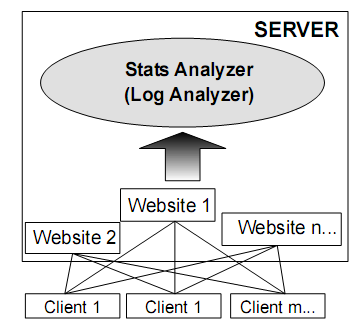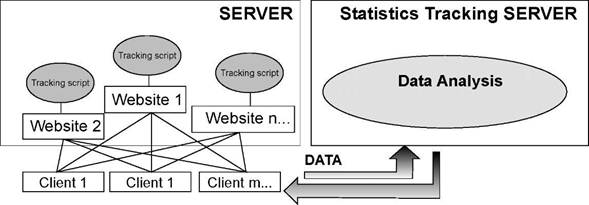Development of a computerized subsystem for organization the structure of commercial website
- Aims
- Introduction
- Formulation of research problems
- Description of the data mining models
- Application of artificial neural networks for analyzing visitors tracks
- Conclusions
- References
The main aim of my masters’ work is to create a computerized subsystem for organization the structure of commercial websites using intelligent classification methods.
Objectives of work:
- provide the universal implementation in existing e-commerce website;
- identify and collect the statistical data from e-commerce website;
- arrange data storage for the statistical data;
- apply intelligent methods for statistical data analysis.
E-commerce is one of the fastest growing sectors in Ukrainian and CIS countries trade market. Ukrainian e-commerce market has demonstrated an annual growth rate about 50-60% for the last 5 years, regardless of permanent economic fluctuations. Still this market has great potential. The capacity of Ukrainian e-commerce market is less than $ 400 - $ 500 million compare with German market which has been estimated in $36 billion [1].
Fundamental platform for e-commerce business are websites. This fact is an evidence of strong connection between computer science and e-commerce sales. Fast development of interactive online platforms, growing amount of internet users, rapidly increasing influence of social networks, web-services transition from Web 2.0 to Web 3.0 platform also shows future market potential.
However, e-commerce faces many problems, some of them make this industry more specific than the other types of trading. Internet marketing is a good example of a such kind of problem.
The main purpose of Internet marketing - is to get the maximum economic benefit from the potential audience of e-commerce website.
Interactivity, determination of the target e-commerce website audience, the post-click analysis are the main advantages of internet marketing, they lead to the maximization of the indicators such as:
- Conversion of the site (the ratio of buyers to the number of visitors, expressed as a percentage);
- ROI (Return of Investments) - performance measure used to evaluate the efficiency of an investment or to compare the efficiency of a number of different investments [2].
Creating an automated subsystem for collecting information about e-commerce websites visitors, and further analysis will enhance the effectiveness of marketing decisions in future.
Traditional methods to collect marketing data a direct mailing to customers, telephone interviews, focused group discussions and so on. Customers just have to respond like or dislike of a particular product, what improvements they would like to see, and what does not. Although these methods provide a high quality of the data, they require much more time and cost. The rapid growth of the Internet creates opportunities for the direct online marketing research. There are several methodologies for this market research. Are traditional online voting, ratings, products, reviews, etc. Another way is to analyze data traffic statistics of commercial web sites. The main focus of this analysis is aimed at the user navigation path between the pages of a commercial web service - “clickstreams”. Analyzing these flows marketing managers can take appropriate measures and find the right solutions to increase the marketing effectiveness of website [4].
Visitor tracks and knowledge from where they come is essential in building website business, marketing and investment strategies. Two common models of website visitors tracking are: Server Side Tracking systems (Figure 1) and Client Side Tracking (CST) systems also known as real time tracking systems (Figure 2).


The client side based tracking system has some noticeable advantages against server side tracking. First of all, information is collected in realtime, when the visitor browses a website and marketing manager may take actions and make marketing decisions at the same time when the visitor is browsing a website.
The following indicators that can be analyzed and improved due to the collected data:
- prediction of attendance;
- effectiveness of the website;
- esign, navigation, speed, operation;
- ROI;
- marketing strategy to attract new users and the conservation of old;
- search engine optimization (SEO);
- business strategy (product line, software updates, discounts) [5].
There are many areas and aspects of commercial websites, where the application of intelligent methods could solve the problem or identify the problems of these websites using their statistics.
As mentioned before, that could be the design of the site, the price of products, improvement of software, etc. In my work, ANN are used for marketing strategy advancing, specially to determine which marketing methods are most effective and attract potential website customers. Neural networks as a possible solution were chosen due to their high efficiency in solving non-linear problems because a clickstream to readable data mapping has a high non-linear trend due to highly unpredictable website visitor behavior [3].
After analyzing the existing data mining models for collecting information about websites clients, the Client Side Statistics Tracking Model has been chosen. Collection information about website clients and its analyzing using artificial neural networks will allow managers to effectively control e-commerce website structure and product range avoiding the painful market subsidence.
- «Онлайн торговля в Украине. Новые возможности для традиционных розничных сетей» С. Гурьев, Ф. Филлипс, А. Калиниченко. - http://www.appletonmayer.com/data/research/2010/1021/
- Wikipedia.org - Return on Investment - http://en.wikipedia.org/wiki/Return_on_Investment
- «Application of intelligent methods in commercial website marketing strategies development» Noreika Algirdas, ISSN 1392 - 124x Information technology and control, 2005, vol. 34, no. 2.
- «Организация сбора информации для повышения эффективности маркетинга коммерческих веб-сайтов» Шумаев К.К., Светличная В.А., Шумаева Е.А. - Інформаційні управляючі системи та комп'ютерний моніторинг (ІУС КМ-2011)/ Збірка матеріалів IІ всеукраїнської науково-технічної конференції студентів, аспірантів та молодих вчених (I том) – 11-13 квітня 2011 р., Донецьк, ДонНТУ – 2011, с. 294-297.
- Yao J., Teng N., Poh H.-L., Tan C.L. Forecasting and Analysis of Marketing Data Using Neural Networks. Journal Of Information Science And Engineering Vol.14, 1998, 843-862.
Important!
This abstract hasn't been completed yet. The date of final completion is December 2011. Full text of the work and materials on the subject of master work may be obtained from the author or his scientific adviser after the final date.
